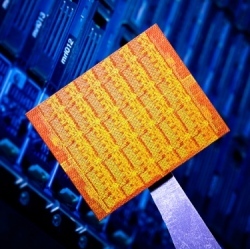
New research by the Rice University lab of Qianfan Xu has produced a micron-scale spatial light modulator (SLM) like those used in sensing and imaging devices, but with the potential to run orders of magnitude faster. Unlike other devices in two-dimensional semiconducting chips, the Rice chips work in three-dimensional “free space.”
The manipulation of light has become central to the information economy. Think about light-reflecting compact discs and their video variants and all the ways lasers are used, from sensing to security to surgery. Light carries data through optical fibers for telecommunications and signals on the molecular scale as photonics techniques improve. Light-emitting diodes power television displays (for viewers clutching infrared remotes) and are beginning to replace the inefficient light bulbs in homes.
But in the computer space, light has been bound and gagged by two-dimensional circuitry, tied to waveguides that move it from here to there, Xu said. He and his colleagues point out in the new paper that 2-D systems fail to take advantage of “the massive multiplexing capability of optics” made possible by the fact that “multiple light beams can propagate in the same space without affecting each other.”
The researchers see great potential for free-space SLMs in imaging, display, holographic, measurement and remote sensing applications.
